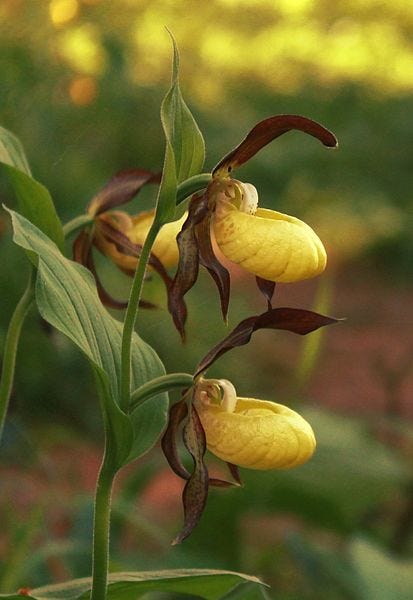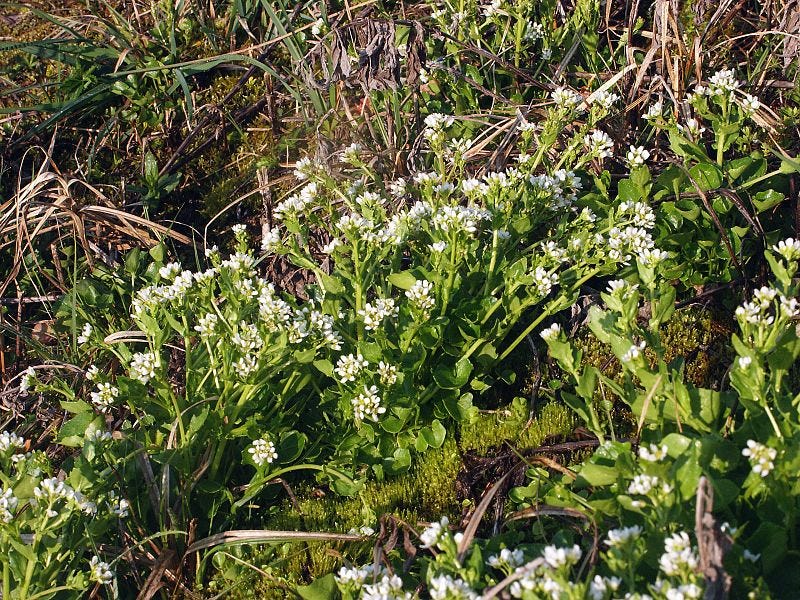The first time we find Thomasin Tunstall’s name mentioned in existing historical records is in John Parkinson’s great English plant encylopedia of 1629 entitled (take a deep breath!) Paradisi in sole paradisus terrestris. or A garden of all sorts of pleasant flowers which our English ayre will permitt to be noursed vp with a kitchen garden of all manner of herbes, rootes, & fruites, for meate or sause vsed with vs, and an orchard of all sorte of fruitbearing trees and shrubbes fit for our land together with the right orderinge planting & preseruing of them and their vses & vertues collected by Iohn Parkinson apothecary of London 1629.

But wait, let’s learn a bit more about him before we go any further. John Parkinson was born in Yorkshire in 1567, twelve years Tunstall’s senior. At the age of 14, he was able to move to London and become an apprentice apothecary, that is, an old-fashioned pharmacist — in Elizabethan England, it was someone who specialized in medicinals and treatments derived not only from plants, but also animal parts (including their excretions), minerals, and bleeding…lots of bleeding (for a fascinating and horrifying description of a London physician’s attempt at reviving the Earl of Kent after he collapsed, unconscious, in 1702, read this).
Apothecaries were trained botanists as well, and so their membership within the Grocer’s Company as a regulating body, seemed to make sense. But as the role of practicing apothecaries grew, for they became increasingly involved in treating the poor and sick (remember, in 1625 the bubonic plague had killed 40,000 residents in London alone), they gathered together to create their own overseeing body. As such, Parkinson was a founding member of the newly established Worship Society of Apothecaries of London in 1617.
Parkinson was very active in the Society’s governing body, even helping to establish the list of medicines that should be stocked in apothecaries. He was also on the committee of the Society’s first publication, Pharmacopœia Londinensis (London Pharmacopœia) in 1618. He was apothecary to King James I until his death in 1625 and then became botanist to the new monarch, Charles I, that same year until his own death in 1650.
The keen interest that Parkinson had for the cultivation and use of flowering plants, not simply for their medicinal purposes but also “for pleasure”, heralded a new attitude toward growing plants.
“I would heartily aduise all men of meanes, to be stirred vp to bend their mindes, and spend a little more time and trauell in these delights of herbes and flowers, then they haue formerly done, which are not onely harmlesse, but pleasurable in their time, and profitable in their vse.”
Like many of his contemporaries who were not merely interested in local plants, he set his sights abroad and financed the plant hunter William Boel in his journey to Iberia and North Africa in 1617-18. When Boel returned with many exotic specimens, Parkinson planted these at his botanical garden at Long Acre, Covent Garden. He was also friends with John Gerard (1545-1612; author of THE HERBALL OR GENERALL HISTORIE OF PLANTES. LONDON: JOHN NORTON, 1597) and John Tradescant the Elder (1570s-1638; Keeper of his Majesty's Charles I Gardens, Vines, and Silkworms at his queen's minor palace, Oatlands Palace in Surrey), among others. He had fruitful relationships with local plant hunters, botanists and plant lovers who could find and secure interesting and rare flowering plants for his garden, which would also be featured in two encylopedia, one published in 1629 and the other, 1640.
This brings me finally to Tunstall.
With this new interest in flowering plants and a market for them provided by wealthy pleasure gardeners, apothecaries and botanists, enterprising plant lovers like Tunstall probably recognized that this might be a way for her to generate some income. Sadly, the job of “gardener” during her lifetime was only the purview of men; women were unceremoniously employed as weeders, often the wives of the gardeners who worked at an estate, and paid a paltry wage of 2-3 d per day, which is 2-3 pennies. It would be helpful now to remind the reader that 12 pennies (“d”) equals 1 shilling; and 20 shillings equals 1 pound. (Recall how Thomasin and another woman, perhaps her sister, were fined 2 pounds 10 shillings a year for their crime of being Roman Catholic in 1629, which would take a long, long, long time to pay - you do the math!)
Although Tunstall was originally from a family of means, from 1605 onward (she would have been 26 years old and unmarried), she had to retreat from Thurland Castle when her brother, her father’s heir, sold it. She may have temporarily returned to her ancestral home at Skargill, Yorkshire, but in the end settled in “Bull-banke”, just south of Thurland Castle and near her namesake town of Tunstall.
Thomasin became aware that Parkinson was looking for plant specimens, namely their roots for propagating, so that he could grow them himself and describe their physical, floral and medicinal properties for his upcoming manuscript. Along with two other gentlemen plant hunters in the area (Thomas Penny, who was a Roman Catholic priest, then field botanist, physician and entomologist; and Thomas Hesketh, also a Roman Catholic and then a doctor, who was a regular plant hunter for both Gerard and Parkinson) Tunstall searched mainly in Helks Wood, which was about seven miles south of her home in Bull-banke.

This was an area rich with botanical treasures, not least of which was the Cypripedium calceolus, known as the Ladies Slipper orchid. It grows primarily in this region of England, but also across Europe, north through Russia and as far east as China and Japan.

Of the three terrestrial orchids that Tunstall sent him, Parkinson described the Lady slipper orchid as “This most beautifull plant of all these kindes”. It is the largest orchid in Europe and thrives in open or semi-shaded woodland in moist, calcerous soils. It cannot survive extreme conditions, that is, waterlogging or the hot, midday sun. For a plant that is about 60 cm tall, the flowers are relatively small at two inches, but have a striking appearance with their bulbous chins that remind me of Jay Leno’s profile. The long, twisted narrow petals that range from red-brown to black extend outwards as if they’re having a bad hair day. This orchid is a very slow grower, taking twelve years to achieve flowering from seed. But it makes up for this slow growth with its longevity: singular plants can live for over thirty years, sometimes even more than one hundred!
Besides this striking orchid, Tunstall found and sent three other native plants to Parkinson including Cardamine pratensis ‘Flore pleno’ (the double form of Cuckoo flower or Lady’s smocks, which looks like a cross between our wild phlox and baby’s breath), Cephalanthera longifolia (Narrow leaved helleborine) and Cochlearia pyrenaica (Pyrenean scurvygrass).

Other writers have mistaken the Helleborine (called ‘Elleborine’ by Parkinson, but known by the botanical name Cephalanthera) as Hellebore, a different genus altogether and not an orchid at all, although an excellent shade perennial.
Cochlearia was collected later and included in Parkinson’s second tome called Theatrum Botanicum (The Botanical Theatre or Theatre of Plants) published in 1640. This indicates that Tunstall was collecting specimens for many years and may likely have developed a mutually beneficial relationship with other plant hunters as well as respected collectors and wealthy patrons.

Parkinson wrote of the double Lady’s smocks that Tunstall sent him, Cardamine trifolia ‘Flore Pleno’, which:
“..is found in divers places of our own Counterey, as neer Micham about eight miles from London, also in Lancashire, from whence I received a plant, which perished, but was found by the industrie of a worthy Gentlewoman, dwelling in those parts heretofore remembred, called Mistresse Thomasin Tunstall, a great lover of these delights.”
It seems evident from this long-standing relationship with Parkinson that he admired Tunstall as being both industrious and adept at finding plants that would be of interest to him, but also careful to dig them at the right time (likely when they were dormant) and package them carefully so that they would get to him in London before they perished. Lord knows that many of us have experienced disappointment when live plants have come through the post damaged and even dead. And keep in mind: Tunstall is over 250 miles north of London, which would take about five days to travel by horse in the early 1600s — not a hop, skip and jump by any means and plenty of time for a precious cargo like living plants to expire.
Stay tuned for Part III which will travel further down the rabbit hole…



